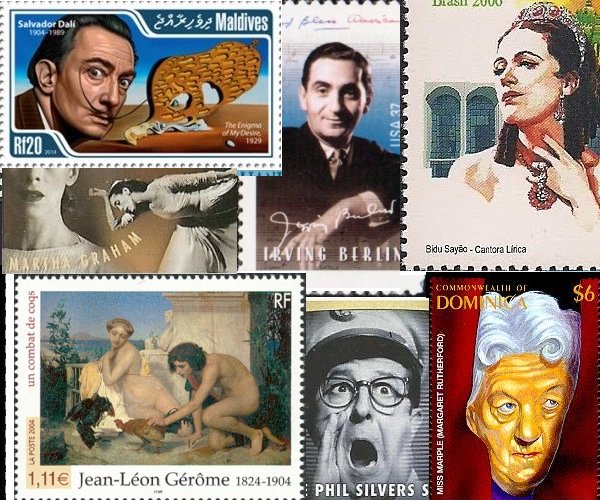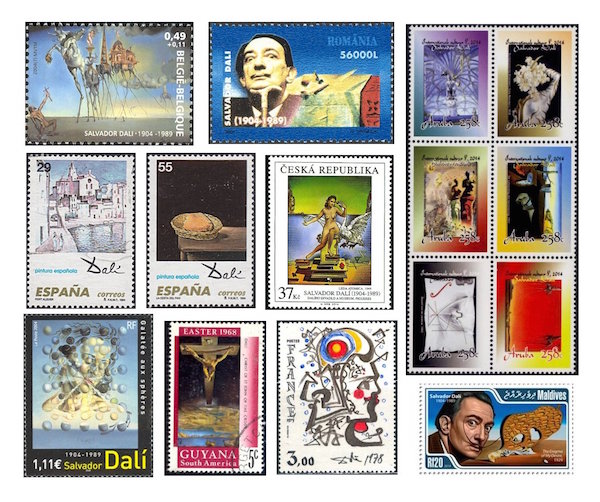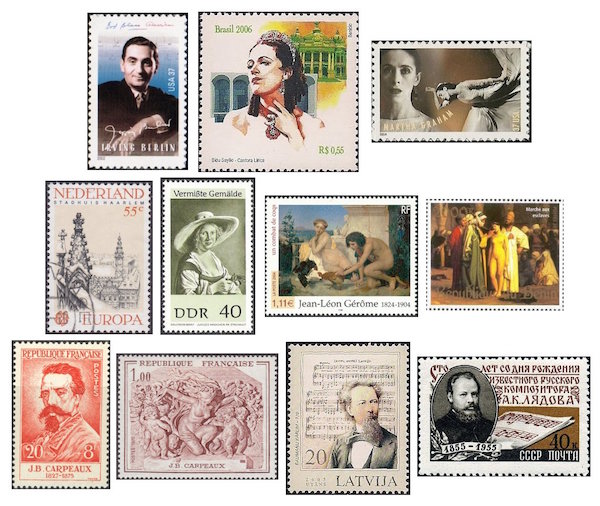The Arts on the Stamps of the World — May 11
An Arts Fuse regular feature: the arts on stamps of the world.

By Doug Briscoe
It’s been awhile since we’ve had a huge (not merely busy) day here on The Arts on the Stamps of the World, so we were due for another mega-bash. Born on this date were Salvador Dalí, Irving Berlin, Bidu Sayão, Martha Graham, Camilo José Cela, Jean-Léon Gérôme, Margaret Rutherford, Phil Silvers, and several other interesting artistic types.
With his ostentatious showmanship, Salvador Domingo Felipe Jacinto Dalí i Domènech, Marqués de Dalí de Púbol (11 May 1904 – 23 January 1989) irritated both his admirers (who thought him a serious artist demeaning his work with his clowning) and his critics (who hated that he got rich and famous from it). I was not dismayed to find a wide array of Salvador Dalí stamps, so for me it was just a question of which ones to omit. I chose examples from Belgium, Romania, Spain, the Czech Republic, France, Guyana, and the Maldives, and a sheet of six from Aruba (first time I’ve had occasion to use any stamps from Aruba here.) Since we have so much ground to cover today, I’ll leave out the titles, but I’m always happy to respond to any questions you may have about anything you see in these pages.
Another 20th-century icon was American songwriter Irving Berlin (1888 – September 22, 1989), born Israel Beilin somewhere in Russia. His home was burned to the ground by Cossacks in a pogrom when he was five. The family emigrated to New York, and Russia’s loss was America’s gain. As his father had been a cantor, young Israel earned pennies singing as a street performer and then in a café, where he wrote his first song. In 1911 “Alexander’s Ragtime Band” made him famous, and by 1918 he had written hundreds of songs. Later hits included “Puttin’ on the Ritz”, “Easter Parade”, “God Bless America”, and “White Christmas”. (We just showed stamps for the people most associated with those last two songs, Kate Smith and Bing Crosby, last week.) Irving Berlin lived to be 101.
Born in Rio, where she made her debut at 18, the great soprano Bidu Sayão (1902 – March 13, 1999) studied with Elena Teodorini and Jean de Reszke. She enjoyed a brilliant career, appearing at La Scala in 1930 and the Paris Opéra in 1931 and starring at the Met from 1937 to 1952. She left a considerable body of splendid recordings, the last of which was of her friend Villa-Lobos‘ cantata “Forest of the Amazon”. In her retirement she lived in Lincolnville, Maine, and her ashes were scattered in the bay. A Bidu Sayão International Vocal Competition was established in 2000 in Belo Horizonte, Brazil.

The importance of Martha Graham (1894 – April 1, 1991) is such that she has been styled the “Picasso of Dance”. Born in Pennsylvania, she moved with her family to California at 14 and began dance studies only after seeing Ruth St. Denis in 1911. She founded the Martha Graham Center of Contemporary Dance in New York in 1926 and continued dancing well into her seventies. As a choreographer she collaborated with many important composers such as Copland (Appalachian Spring), Barber (Medea and Cave of the Heart), William Schuman (Night Journey and Judith), Hindemith (Hérodiade), and Dello Joio (Diversion of Angels). When at last it became impossible for her to appear on stage, she fell into a debilitating depression and alcoholism and even attempted suicide, but she recovered fully and went on to choreograph ten new ballets before her death from pneumonia at the age of 96.
For the rest of today’s people we revert to chronology. Netherlandish painter, silversmith, architect, city planner, and poet Salomon de Bray was born in 1597 in Amsterdam and died on this day in Haarlem in 1664. This man of such diverse talents also wrote a book (Architectura Moderna) about the lives and work of Dutch architects Hendrick de Keyser and Cornelis Danckerts de Ry. For Nijmegen he designed the city orphanage. As town planner for the city council of Haarlem he was involved in the construction (or expansion) of City Hall in 1630. The building is seen in the background on a Belgian stamp. Another depicts his painting Young Girl in Straw Hat, which has been missing since World War II. Three of de Bray’s sons (Dirck, Jan, and Joseph) also became artists.
I’m a sucker for the paintings of Jean-Léon Gérôme (11 May 1824 – 10 January 1904), considered one of the most significant exponents of academicism. Known for historical and mythological paintings, he was also an orientalist, much traveled, visiting Constantinople in 1853, Greece and Turkey the next year and, something of a turning point, Egypt in 1856. Thereafter he became fascinated with the world of the Arabs and Islam, as reflected, very strikingly, in his work The Snake Charmer of about 1879, in which the light from behind the viewer is ingeniously dispersed on the blue tiles of the facing wall. I first saw this painting while visiting the Sterling and Francine Clark Art Institute, where it hangs today. The French and Beninese stamps offer two of Gérôme’s most characteristic works, The Cock Fight (1846), much admired by Théophile Gautier, and The Slave Market (1866). He was also a sculptor and teacher of many students including Mary Cassatt, Thomas Eakins, and Odilon Redon.

Another French sculptor and painter, Jean-Baptiste Carpeaux (1827 – 12 October 1875), shares this birthday with Gérôme. He studied under the fine sculptor François Rude and won the Prix de Rome in 1854. He remained there (in Rome, that is) until 1861. The two French stamps give us the man himself (after a portrait by Auguste Moreau-Deschanvres) and Carpeaux’s Triumph of Flora (1866), a relief designed for the South façade of the Pavillon de Flore at the Louvre. Here is a photo of the work in context.
Latvian composer Kārlis Baumanis (or Baumaņu Kārlis, 11 May [O.S. 29 April] 1835 – 10 January [O.S. ] 1905) wrote the music and lyrics for the Latvian national anthem along with some other songs, besides making folksong arrangements. He earned his living as a teacher and journalist.
The Russian Anatoly Liadov (1855 – August 28 [O.S. August 15] 1914), an excellent teacher whose students included Prokofiev and Miaskovsky, wrote carefully crafted small-scale piano works and orchestral pieces such as Baba Yaga, The Enchanted Lake, and Kikimora (ki-KEE-mo-ra). He eschewed the larger forms—symphony, concerto, opera—altogether.
The only stamp I could locate showing the work of British artist Paul Nash (11 May 1889 – 11 July 1946) is one of a print design (“Cherry Orchard”) from the late 1920s. Described as “among the most important landscape artists of the first half of the twentieth century,” he was also an official artist during World War I and left an important body of work reflecting that conflict. Nash also produced photography, book illustrations, stage scenery, fabrics, and posters.
I wasn’t planning to write much about Dame Margaret Rutherford (11 May 1892 – 22 May 1972), but reading her story convinced me otherwise. Her father was plagued with mental illness and violently murdered his own father (this was well before Margaret’s birth), and her mother hanged herself when Margaret was three. For the rest of her life she lived with the fear of succumbing to mental illness and did suffer from depression, with periodic hospitalizations, and, at the end, Alzheimer’s. She was brought up by her aunt in London. She achieved notice with her performances in the film versions of Blithe Spirit (1945; the phrase “A Blithe Spirit” is inscribed on her tombstone) and The Importance of Being Earnest (1952). Later she went on to portray Agatha Christie’s Jane Marple in four movies from the early 60s. Her stamp, showing her in that role, comes from a Dominican minisheet commemorating famous fictional detectives. She won a best supporting actress Oscar for The V.I.P.s (1963) and was named a Dame Commander (DBE) in 1967.

Croatian composer Josip Štolcer-Slavenski (1896 – 30 November 1955) studied with Kodály and wrote orchestral, chamber, vocal, and piano music. Like Liadov, he never wrote an opera or a symphony, but did produce a Violin Concerto, a Piano Concerto, and four string quartets. (An imaginary gold cigar to anybody who can tell me what the heck those objects are that are shown on his stamp. Looks to me like a big thread bobbin and a pair of aluminum chopsticks.)
Estonian painter Karl Pärsimägi died at Auschwitz. Born on 11 May 1902, he took part in the Estonian War of Independence at 17 and was decorated. He studied at the Pallas Art School in Tartu and took to the Fauvist school, with influences also from Estonian folk art. Further studies in Germany were followed by an exhibition in 1923 and a move to Paris in 1937. There a new influence, that of Cézanne, made itself felt in his work. For reasons that remain unclear (offering help to a Jewish friend? involvement in the Resistance? sexual orientation?), he arrested by the Gestapo in 1941. His death at Auschwitz occurred on 27 July 1942. The Estonian stamp offers us his 1936 painting The Girl and the Moon (Tütarlaps ja kuu).
American comedic actor (he never did standup) Phil Silvers (May 11, 1911 – November 1, 1985) used to sing at movie theaters as a kid whenever the projector broke down (which happened rather a lot in those days) and finally was allowed free admission as long as he kept it up. His own first feature film appearance was in Hit Parade of 1941. He worked as a character actor in the movies for the next twenty years, while also appearing on Broadway, where in 1952 he won a Tony for Top Banana. (He would win another one for the 1972 revival of A Funny Thing Happened on the Way to the Forum.) His immortality, though, was secured in 1955 with the character of Sergeant Bilko in You’ll Never Get Rich, later renamed The Phil Silvers Show. Like Margaret Rutherford, he also suffered from chronic depression. Incidentally, during the war he wrote the lyrics for Frank Sinatra’s “Nancy (With the Laughing Face)” (music by Jimmy Van Heusen) and went on to perform with Sinatra in USO tours. Phil Silvers was nicknamed “The King of Chutzpah”.
It’s time for yet another Nobel Prize winner. Spanish novelist Camilo José Cela (11 May 1916 – 17 January 2002) won the award in 1989 and was ennobled by Juan Carlos I in 1996, thus becoming the 1st Marquis of Iria Flavia. After a blissfully happy childhood he contracted tuberculosis in 1931 and started working on a novel while recovering at a sanatorium. At this time he also devoured the works of José Ortega y Gasset (whose stamp we saw here the day before yesterday). Just as he was returning to health the Spanish Civil War broke out, and Cela, a lifelong political conservative, escaped to join the Nationalists only to be wounded. Again presented with spare time, he went to work on his first (finished) novel, La familia de Pascual Duarte (The Family of Pascual Duarte), which was not published until 1942. This book bears a similarity to Camus’s novel The Stranger, which came out the same year. Despite his conservatism Cela’s work was banned by Spanish censors for its eroticism and alleged immorality, this while he was informing the police on the activities of dissident groups. In 1950 he published the novel La colmena (The Hive), which shows the stylistic influence of Benito Pérez Galdós (whose birthday was yesterday!) as well as Joyce, Dos Passos, and Sartre and anticipates magic realism. His later work became more and more experimental, perhaps culminating in Cristo versus Arizona (Christ versus Arizona), a retelling of the gunfight at the O.K. Corral consisting of a single sentence a hundred pages long.
One more thing for today: Portugal’s Museu Nacional de Arte Antiga in Lisbon was formally founded on this day in 1884. This gives me the excuse to show a stamp featuring one of the gallery’s treasures, work by the 15th-century court painter Nuno Gonçalves, whose dates of birth and death are unknown. We see a detail from his Panels of Saint Vincent, executed in the 1460s.
I hope Stanley Elkin (May 11, 1930 – May 31, 1995) gets a stamp one day.
A graduate of the University of Massachusetts with a B.A. in English, Doug Briscoe worked in Boston classical music radio, at WCRB, WGBH, and WBUR, for about 25 years, beginning in 1977. He has the curious distinction of having succeeded Robert J. Lurtsema twice, first as host of WGBH’s weekday morning classical music program in 1993, then as host of the weekend program when Robert J.’s health failed in 2000. Doug also wrote liner notes for several of the late Gunther Schuller’s GM Recordings releases as well as program notes for the Boston Classical Orchestra. For the past few years he’s been posting a Facebook “blog” of classical music on stamps of the world, which has now been expanded to encompass all the arts for The Arts Fuse.
